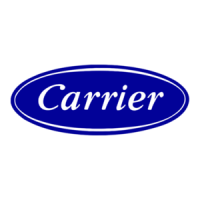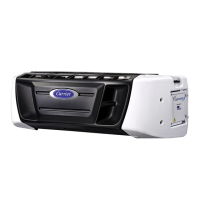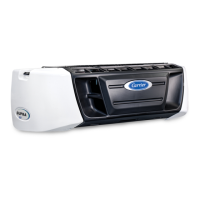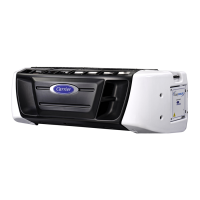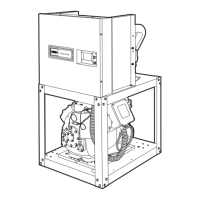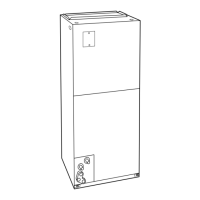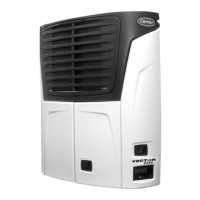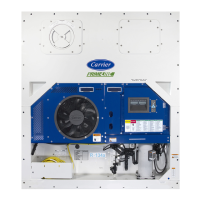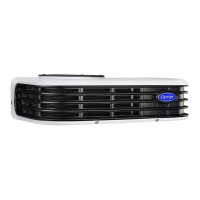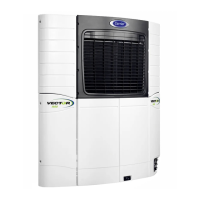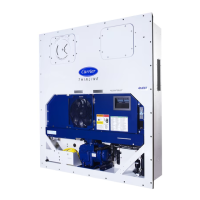3-10T -309
3.6.4
Logging Interval (dCF03)
The user may select four different time intervals
between data recordings. Data is logged at exact
intervals in accordance with the real time clock. The
clock is factory set at Greenwich Mean Time (GMT).
3.6.5 Thermistor Format (dCF04)
The user may configure the format in which the
thermistorreadingsarerecorded.Theshortresolutionis
a1byteformatandthelongresolutionisa2byteformat.
Thes hortrequireslessmemoryandrecordstemperature
in0.25°C(0.45°F)stepswhenintheperishablemodeor
0.5°C (0.9°F) steps when in the frozenmode. The long
records temperature in 0.01°C (0.02°F) steps for the
entire range.
3.6.6 Sampling Type (dCF05 & dCF06)
Three types of data sampling are available, average,
snapshot and USDA. When configured to average, the
average of readings taken every minute over the
recording period is recorded. When configured to
snapshot, the sensor reading at the log intervale timeis
recorded. When USDA i s configured the supply and
return temperature readings are averaged and the 3
USDA probe readings are snapshot.
3.6.7 Alarm Configu ration (dCF07 -- dCF10)
The USDA and cargo probe alarms may be configured
to OFF, ON or AUTO.
IfaprobealarmisconfiguredtoOFF,thenthealarmfor
this probe is always disabled.
IfaprobealarmisconfiguredtoON,thentheassociated
alarm is always enabled.
If the probes are configured to AUTO, they act as a
group. This function i s designed to assist users who
keep their DataCORDER configured for USDA
recording, but do not install theprobesforevery t rip. If
all theprobesaredisconnected, noalarmsareactivated.
As soon asoneofthe probesis installed, thenall ofthe
alarmsareenabledandtheremainingprobesthatarenot
installed will give active alarm indications.
The DataCORDER will record the initiation of a
pre-trip test (refer to paragraph 3.5) and the results of
each of the tests included in pre--trip. The data is
time-stamped and may be extracted via the Data
Retrieval program. Refer to Table 3-9 for a description
of the data stored in the DataCORDER for each
corresponding Pre-Trip test.
3.6.8
DataCORDER Power-Up
The DataCORDER may be powered up in any one of
four ways:
1. No rmal AC power: The DataCORDER is powered
up when the unit is turned on via the stop-start switch.
2. ControllerDCbatterypackpow er:Ifabatterypack
is installed, the DataCORDER will power up for
communication whenaninterrogationcableis plugged
into an interrogation receptacle.
3. ExternalDC batterypackpower: A 12 volt battery
pack may also be plugged into the back of the
interrogation cable, which is then plugged into an
interrogation port. No controller battery pack is
required with this method.
4. Real Time Clock demand: If the DataCORDER is
equipped with a charged battery pack and AC power is
not present, the DataCORDER will power up when the
real time clock indicates that a data recording should
take place. When the DataCORDER is finished
recording, it will power down.
During DataCORDER power-up, while using
battery-pack power, t he controller will perform a
hardware voltage check on the battery. If the hardware
checkpasses,theController willenergizeandperforma
software battery voltage check before DataCORDER
logging. If either test fails, the real time clock battery
power-up will be disabled until the next AC power
cycle. FurtherDataCORDER t emperature logging will
be prohibited until that time.
An alarm will be generated when the battery voltage
transitions from good to bad indicating that the battery
pack needs recharging. If the alarm condition persists
for more than 24 hours on continuous AC power, the
battery pack needs replacement.
3.6.9 Pre-Trip Data Recording
The DataCORDER will record the initiation of a
pre-trip test (refer to paragraph 3.5) and the results of
each of the tests included in pre--trip. The data is
time-stamped and may be extracted via the Data
Retrieval program. Refer to Table 3-9 for a description
of the data stored in the DataCORDER for each
corresponding Pre-Trip test.
3.6.10 DataCORDER Communications
Data retrieval from the DataCORDER can be
accomplished by using one of the following;
DataReader, DataLine/DataView or a communications
interface module.
a. DataReader
The Carrier TransicoldData Reader(see Figure 3- 6)is
asimpletooperatehandhelddevicedesignedtoextract
data from the DataCORDER and then upload it to a
personal computer. The Data Reader has the ability to
storemultipledatafiles.RefertoDataRetrievalmanual
62-02575 for a more detailed explanation of the
DataReader
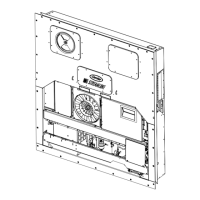
